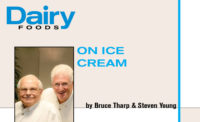Formulating Chocolate Ice Cream
How many ways can you formulate chocolate ice cream?

How many ways can you formulate chocolate ice cream? After vanilla, chocolate ice cream might be the most critical flavor to success in many ice cream product portfolios. On average, simple, straight chocolate ice cream is ~8-10% of any given portfolio volume. Perhaps even more importantly, ~80% of all ice cream products are either vanilla-based or chocolate-based. As with vanilla, the importance of chocolate ice cream cannot be understated. However, the flavor, taste, and execution of chocolate ice cream can be highly variable and highly polarizing as well. The task of finding the “right” chocolate flavor profile for any given market is challenging.
Typically, chocolate ice cream is made with 2-4% added cocoa powder (either 10-12% or 20-22% cocoa butter). Occasionally, chocolate liquor, with 50% cocoa butter, is used. Important variables include: cocoa butter (fat) content; particle size; color; processing; pH; solubility; bean source; and treatment of beans. Proper selection of the type and level used to deliver any desired chocolate flavor (and color) profile is critical.
Color of cocoa powder can vary from yellowish-brown through light brown (lightly alkalized), reddish brown, and dark brown to black. Color also involves the contribution of other mix ingredients, processing, and the overrun of the finished ice cream.
Since the flavor of cocoa powder/liquor comes from the non-fat portion, the flavor profile becomes more intense and, in general, harsher, as the fat decreases. Cocoa fat does a great job rounding off harsh/bitter notes, making higher fat powders desirable. However, the lower flavor intensity requires higher levels, resulting in a higher cost.
Further differentiation of a chocolate ice cream can be achieved by adding background flavors either to enhance flavor (e.g., vanilla, salt, fudge, cream flavors, etc.) or to create novel flavors (e.g., coffee for mocha).
It is also possible to leverage the apparent goodness of dark chocolate by offering classical dark colored, harsh-to-bitter chocolate taste. These cocoas should be selected on the basis of their natural flavanol composition. Claims relevant to that approach should be discussed with the supplier and reconfirmed by a regulatory authority.
Although separate mixes for chocolate ice creams are usually prepared, other possibilities exist. Chocolate syrup can be used to convert a white mix to chocolate at the flavor tank. The 2% - 3% additional sweetness needed in chocolate is provided by an appropriate level of sweetener in the syrup. Conceptually, chocolate flavor/color could be “injected” into finished ice cream in the form of a syrup with appropriate sweetness (or even whipped/frozen ice cream-like flavoring). Variations related to color, flavor distribution, and visual effects are possible by adjusting the level of in-line mixing. Issues to consider in this practice include: flavor and sweetness compatibility with the ice cream; temperature control of syrup delivery to avoid excess heat shock and facilitate co-mixing; and uniform (or not) incorporation of chocolate syrup into frozen ice cream. Also, keep in mind that it is necessary that anything added after pasteurization must have been rendered pathogen free by an FDA-approved process.
Making chocolate from a single white mix could offer manufacturing efficiencies while allowing a variety of chocolate flavored executions without need for additional mixes. However, these practices do not always produce the flavor associated with the thorough amalgamation of the chocolate components that is accomplished by pasteurizing and homogenizing the chocolate source with the complete mix.
Chocolate ice cream is subject to the bulky flavor provisions of the FDA Standard of Identity. That is, the level of chocolate flavoring, multiplied by a factor of 2.5, can be considered as separate from the ice cream portion in establishing minimum requirements for fat and total milk solids. For example, a product with 4% cocoa contains 10% bulky flavor (4 x 2.5) and, by difference, 90% ice cream. The ice cream must conform to the 10% minimum fat and 20% total milk solids requirements. So, the total product must contain at least 9% (90 x 10%) fat and 18% total milk solids (90 x 20%). n
For more on novel ways to flavor ice cream, join Bruce Tharp and Steve Young at Tharp & Young On Ice Cream, December 5-7, 2008, Las Vegas, Nev. For more, go to www.onicecream.com.

How many ways can you formulate chocolate ice cream? After vanilla, chocolate ice cream might be the most critical flavor to success in many ice cream product portfolios. On average, simple, straight chocolate ice cream is ~8-10% of any given portfolio volume. Perhaps even more importantly, ~80% of all ice cream products are either vanilla-based or chocolate-based. As with vanilla, the importance of chocolate ice cream cannot be understated. However, the flavor, taste, and execution of chocolate ice cream can be highly variable and highly polarizing as well. The task of finding the “right” chocolate flavor profile for any given market is challenging.
Typically, chocolate ice cream is made with 2-4% added cocoa powder (either 10-12% or 20-22% cocoa butter). Occasionally, chocolate liquor, with 50% cocoa butter, is used. Important variables include: cocoa butter (fat) content; particle size; color; processing; pH; solubility; bean source; and treatment of beans. Proper selection of the type and level used to deliver any desired chocolate flavor (and color) profile is critical.
Color of cocoa powder can vary from yellowish-brown through light brown (lightly alkalized), reddish brown, and dark brown to black. Color also involves the contribution of other mix ingredients, processing, and the overrun of the finished ice cream.
Since the flavor of cocoa powder/liquor comes from the non-fat portion, the flavor profile becomes more intense and, in general, harsher, as the fat decreases. Cocoa fat does a great job rounding off harsh/bitter notes, making higher fat powders desirable. However, the lower flavor intensity requires higher levels, resulting in a higher cost.
Further differentiation of a chocolate ice cream can be achieved by adding background flavors either to enhance flavor (e.g., vanilla, salt, fudge, cream flavors, etc.) or to create novel flavors (e.g., coffee for mocha).
It is also possible to leverage the apparent goodness of dark chocolate by offering classical dark colored, harsh-to-bitter chocolate taste. These cocoas should be selected on the basis of their natural flavanol composition. Claims relevant to that approach should be discussed with the supplier and reconfirmed by a regulatory authority.
Although separate mixes for chocolate ice creams are usually prepared, other possibilities exist. Chocolate syrup can be used to convert a white mix to chocolate at the flavor tank. The 2% - 3% additional sweetness needed in chocolate is provided by an appropriate level of sweetener in the syrup. Conceptually, chocolate flavor/color could be “injected” into finished ice cream in the form of a syrup with appropriate sweetness (or even whipped/frozen ice cream-like flavoring). Variations related to color, flavor distribution, and visual effects are possible by adjusting the level of in-line mixing. Issues to consider in this practice include: flavor and sweetness compatibility with the ice cream; temperature control of syrup delivery to avoid excess heat shock and facilitate co-mixing; and uniform (or not) incorporation of chocolate syrup into frozen ice cream. Also, keep in mind that it is necessary that anything added after pasteurization must have been rendered pathogen free by an FDA-approved process.
Making chocolate from a single white mix could offer manufacturing efficiencies while allowing a variety of chocolate flavored executions without need for additional mixes. However, these practices do not always produce the flavor associated with the thorough amalgamation of the chocolate components that is accomplished by pasteurizing and homogenizing the chocolate source with the complete mix.
Chocolate ice cream is subject to the bulky flavor provisions of the FDA Standard of Identity. That is, the level of chocolate flavoring, multiplied by a factor of 2.5, can be considered as separate from the ice cream portion in establishing minimum requirements for fat and total milk solids. For example, a product with 4% cocoa contains 10% bulky flavor (4 x 2.5) and, by difference, 90% ice cream. The ice cream must conform to the 10% minimum fat and 20% total milk solids requirements. So, the total product must contain at least 9% (90 x 10%) fat and 18% total milk solids (90 x 20%). n
For more on novel ways to flavor ice cream, join Bruce Tharp and Steve Young at Tharp & Young On Ice Cream, December 5-7, 2008, Las Vegas, Nev. For more, go to www.onicecream.com.
Looking for a reprint of this article?
From high-res PDFs to custom plaques, order your copy today!









